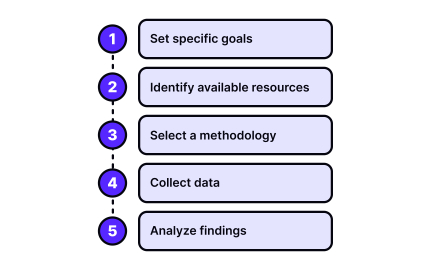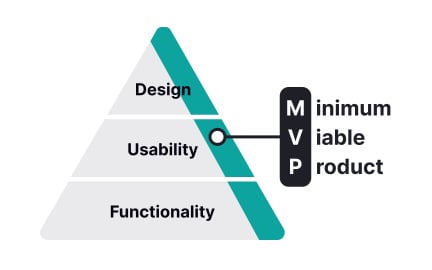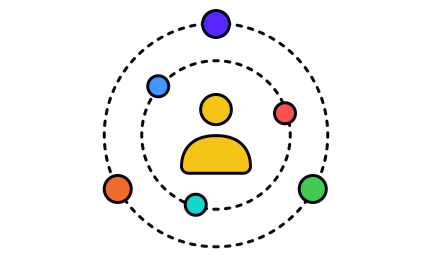Product Vision
A product vision communicates the long-term purpose of a product, aligning teams around what they’re building, for whom, and why it matters.

What is Product Vision?
Your team builds features without clear direction, stakeholders have conflicting ideas about product goals, and development decisions feel reactive rather than purposeful. You've probably experienced the frustration of working hard on a product that lacks coherent direction or inspiring purpose.
Most product teams confuse feature lists with vision, missing the strategic foundation that guides decision-making and inspires teams to build something meaningful that customers will love.
Product vision is the inspiring, clear description of what your product will become and the impact it will have on users' lives, providing strategic direction that guides all product decisions while motivating teams around a shared understanding of success and purpose.
Teams with compelling product visions achieve 60% higher employee engagement, 40% better strategic alignment, and significantly faster decision-making because everyone understands the destination and can evaluate choices against shared objectives.
Think about how companies like Tesla articulated a vision of sustainable transportation that guided every product decision, or how Airbnb's vision of "belonging anywhere" shaped platform development beyond just accommodation booking.
Why Product Vision Matters for Team Success
Your product development lacks strategic coherence because teams don't share understanding of what success looks like, leading to conflicting priorities and solutions that don't serve a unified purpose or customer outcome.
The cost of absent or unclear vision compounds across every development cycle. You get feature creep, team misalignment, stakeholder confusion, and products that feel scattered rather than purposefully designed to achieve specific outcomes.
What compelling product vision delivers:
Better decision-making because vision provides evaluation criteria for features, partnerships, and resource allocation decisions that keep teams focused on what matters most for product success.
When everyone understands where you're going, daily decisions become easier because you can ask "does this move us closer to our vision?"
Higher team motivation through inspiring purpose that connects individual work to meaningful outcomes that improve users' lives rather than just completing assigned tasks.
Faster stakeholder alignment as shared vision reduces debate about priorities and creates common understanding of success criteria that guides planning and resource allocation.
Clearer market positioning because compelling vision attracts customers who share your values and outcomes while differentiating from competitors who lack clear purpose.
More strategic feature development as vision guides what to build and what not to build, preventing scope creep and maintaining focus on capabilities that serve the larger purpose.
Advanced Product Vision Strategies
Once you've established basic vision foundations, implement sophisticated vision development and communication approaches.
Vision Evolution Planning: Design vision that can evolve as markets change while maintaining core purpose and values that guide product development through different growth phases.
Multi-Horizon Vision Framework: Create vision statements that work across different time horizons, from immediate user impact to long-term market transformation goals.
Stakeholder-Specific Vision Communication: Adapt vision communication for different audiences while maintaining consistent core message and strategic direction.
Vision-Driven Innovation: Use vision to identify innovation opportunities and breakthrough features that serve long-term objectives rather than just incremental improvements.
Product vision is a clear and inspiring statement that defines the long-term mission and objectives of a product. It serves as a guiding star for the product team, helping to align efforts and decisions with the ultimate goals of the product. A strong product vision encapsulates the future direction of the product, the problem it aims to solve, and the value it will deliver to users and the market. It provides a shared understanding of what success looks like for the product, ensuring that all stakeholders are working towards the same outcome.
Product vision is important because it provides a clear and inspiring direction for the entire product team and stakeholders. It helps ensure that everyone involved in the product’s development is aligned with the same long-term goals and understands the purpose of the product. A well-defined product vision serves as a foundation for strategic decisions, guiding the prioritization of features, the setting of milestones, and the allocation of resources. Without a strong product vision, teams may struggle to maintain focus and coherence, leading to fragmented efforts and missed opportunities.
The goal of a product vision is to articulate a compelling future for the product that guides its development and inspires the team. It aims to clearly define the problem the product is solving, the target audience, and the ultimate impact the product will have on users and the market. By establishing a long-term direction, the product vision helps to align the product strategy, roadmap, and day-to-day decisions with the overarching mission, ensuring that every effort contributes to the product’s success.
Product vision and product strategy are closely related but serve different purposes. The product vision is a high-level statement that defines the long-term goals and aspirations for the product—it’s the "why" behind the product’s existence. In contrast, the product strategy is a detailed plan that outlines how to achieve the product vision. The strategy focuses on the "how" and "what," detailing the specific actions, features, and initiatives required to bring the vision to life. While the product vision sets the direction, the product strategy provides the roadmap for getting there. Together, they ensure that the product is both visionary and actionable.
Recommended resources
Courses

Design Thinking

Workshop Facilitation

Product Discovery
Lessons

User Research Basics

What is Design Thinking?

Planning the Mobile App Flow
Exercises
Briefs
Projects

Polifinity

Profile Page Design For Job Portal











